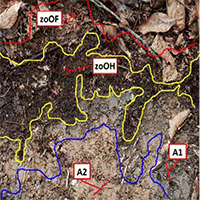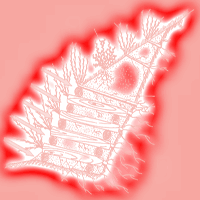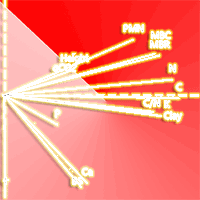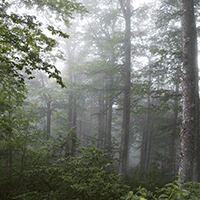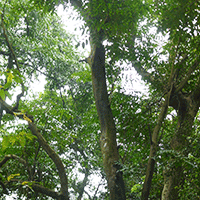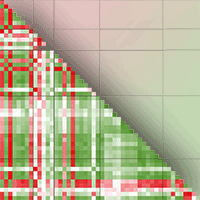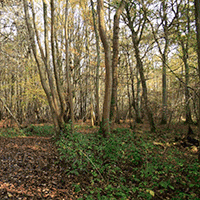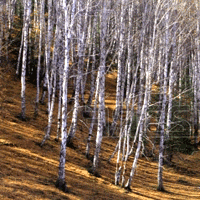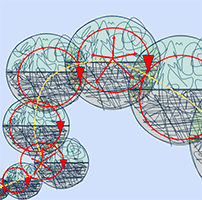Humus forms are good indicators of environmental conditions and thus important in forest ecological processes. Altitudinal gradients are considered as natural laboratory for evaluating soil ecological processes and humus form distribution. The objective of this study was to evaluate the macromorphology of humus forms along an altitudinal gradient (0-2000 m a.s.l.) covered with plain forest, mixed and pure forests and forest-grassland ecotone, in Alborz Mountains in northern Iran. In total, 225 humus profiles were evaluated. Forest stand variables including tree density, basal area, crown density, and height, forest floor and soil physico-chemical properties along with biological features were measured. We found that altitudinal gradients influence both humus forms distribution and soil properties but with different mechanisms. While soil properties (i.e., temperature, pH, CaCO3, soil N content, soil C/N and microbial biomass N) were significantly correlated with altitude, the forest floor properties were more influenced by tree species composition. Particularly, the abundance of Mull was decreased in plain mixed forests compared to mountain pure forests, whereas the frequency of Amphi was increased. Moreover, Oligomull and Leptoamphi were abundant in mixed beech forests, while Eumacroamphi, Eumesoamphi and Pachyamphi were only observed in pure beech forests. Such a distribution influenced soil fertility where higher values of nitrogen (N), microbial biomass nitrogen (MBN) and pH were observed at lower altitudes under mixed forests compared to pure forests at higher altitudes.
Keywords
, , ,
Citation
Bayranvand M, Akbarinia M, Salehi Jouzani G, Gharechahi J, Alberti G (2021). Dynamics of humus forms and soil characteristics along a forest altitudinal gradient in Hyrcanian forest. iForest 14: 26-33. - doi: 10.3832/ifor3444-013
Academic Editor
Maurizio Ventura
Paper history
Received: Apr 09, 2020
Accepted: Nov 02, 2020
First online: Jan 10, 2021
Publication Date: Feb 28, 2021
Publication Time: 2.30 months
© SISEF - The Italian Society of Silviculture and Forest Ecology 2021
Open Access
This article is distributed under the terms of the Creative Commons Attribution-Non Commercial 4.0 International (https://creativecommons.org/licenses/by-nc/4.0/), which permits unrestricted use, distribution, and reproduction in any medium, provided you give appropriate credit to the original author(s) and the source, provide a link to the Creative Commons license, and indicate if changes were made.

Breakdown by View Type
(Waiting for server response...)
Article Usage
Total Article Views: 36974
(from publication date up to now)
Breakdown by View Type
HTML Page Views: 30984
Abstract Page Views: 2605
PDF Downloads: 2766
Citation/Reference Downloads: 4
XML Downloads: 615
Web Metrics
Days since publication: 1805
Overall contacts: 36974
Avg. contacts per week: 143.39
Article Citations
Article citations are based on data periodically collected from the Clarivate Web of Science web site
(last update: Mar 2025)
Total number of cites (since 2021): 11
Average cites per year: 2.20
Publication Metrics
by Dimensions ©
Articles citing this article
List of the papers citing this article based on CrossRef Cited-by.
(1)
Allison LE (1965)Organic carbon. In: “Methods of Soil Analysis American Society of Agronomy. Part 2” (Black CA ed). American Society of Agronomy, Soil Science Society of America, Madison, WI, USA, pp. 1367-1378.
CrossRef |
Gscholar
(2)
Andreatta A, Ciampalini R, Moretti P, Vingiani S, Poggio G, Matteucci G, Tescari F, Carnicelli S (2011)Forest humus forms as potential indicators of soil carbon storage in Mediterranean environments. Biology and Fertility of Soils 47: 31-40.
CrossRef |
Gscholar
(3)
Ascher J, Sartori G, Graefe U, Thornton B, Ceccherini MT, Pietramellara G, Egli M (2012)Are humus forms, mesofauna and microflora in subalpine forest soils sensitive to thermal conditions?. Biology and Fertility of Soils 48: 709-725.
CrossRef |
Gscholar
(4)
Badía-Villas D, Girona-García A (2018)Soil humus changes with elevation in Scots pine stands of the Moncayo Massif (NE Spain). Applied Soil Ecology 123: 617-621.
CrossRef |
Gscholar
(5)
Bayranvand M, Kooch Y, Alberti G (2018)Classification of humus forms in Caspian Hyrcanian mixed forests ecoregion (Iran): comparison between two classification methods. Catena 165: 390-397.
CrossRef |
Gscholar
(6)
Bayranvand M, Kooch Y, Rey A (2017a)Earthworm population and microbial activity temporal dynamics in a Caspian Hyrcanian mixed forest. European Journal of Forest Research 136: 447-456.
CrossRef |
Gscholar
(7)
Bayranvand M, Kooch Y, Hosseini SM, Alberti G (2017b)Humus forms in relation to altitude and forest type in the Northern mountainous regions of Iran. Forest Ecology and Management 385: 78-86.
CrossRef |
Gscholar
(8)
Bohlen PJ (2002)Earthworms. Oligochaeta: Archipheretima, Metapheretima, Planapheretima, Pleinogaster and Polypheretima. Encyclopedia of Soil Science, Bulletin of the British Museum Natural History, Archbold Biological Station, Venus, FL, USA, pp. 1-128.
Gscholar
(9)
Bojko O, Kabala C (2017)Organic carbon pools in mountain soils - Sources of variability and predicted changes in relation to climate and land use changes. Catena 149: 209-220.
CrossRef |
Gscholar
(10)
Bonifacio E, D’Amico M, Catoni M, Stanchi S (2018)Humus forms as a synthetic parameter for ecological investigations. Some examples in the Ligurian Alps (North-Western Italy). Applied Soil Ecology 123: 568-571.
CrossRef |
Gscholar
(11)
Bouyoucos GJ (1962)Hydrometer method improved for making particle size analysis of soils. Agronomy Journal 56: 464-465.
CrossRef |
Gscholar
(12)
Bremner JM, Mulvaney CS (1982)Nitrogen-total. In: “Methods of Soil Analysis, Part 2 (2nd edn)” (Page AL, Miller RH, Keeney RR eds). American Society of Agronomy, Madison WI, USA, pp. 595-624.
Gscholar
(13)
Brookes PC, Landman A, Pruden G, Jenkinson DS (1985)Chloroform fumigation and the release of soil N: a rapid direct extraction method to measure microbial biomass nitrogen in soil. Soil Biology and Biochemistry 17: 837-842.
CrossRef |
Gscholar
(14)
IUSS Working Group (2015)World reference base for soil resources 2014. International soil classification system. World Soil Resources Reports no. 106, Food and Agriculture Organization of the United Nations, Rome, Italy.
CrossRef |
Gscholar
(15)
Guo A, Ding L, Tang Z, Zhao Z, Duan G (2019)Microbial response to CaCO
3 application in an acid soil in southern China. Journal of Environmental Sciences 79: 321-329.
CrossRef |
Gscholar
(16)
Jabiol B, Zanella A, Ponge JF, Sartori G, Englisch M, Van Delft B, De Waal R, Le Bayon RC (2013)A proposal for including humus forms in the World Reference Base for Soil Resources (WRB-FAO). Geoderma 192: 286-294.
CrossRef |
Gscholar
(17)
Karger DN, Conrad O, Böhner J, Kawohl T, Kreft H, Soria-Auza RW, Zimmermann NE, Linder HP, Kessler M (2017)Climatologist at high resolution for the Earth’s land surface areas. Scientific Data 4: 170122.
Gscholar
(18)
Khaleghi P, Abasi H, Hosani S, Frohar M, Ghelichnian H (1997)Caspian forests profile, Vaz Research Forest. Ministry of Jihad-e-Production, Department of Education and Research, Research Institute for Forests and Rangelands, Tehran, Iran, pp. 380.
Gscholar
(19)
Kooch Y, Bayranvand M (2017)Composition of tree species can mediate spatial variability of C and N cycles in mixed beech forests. Forest Ecology and Management 401: 55-64.
CrossRef |
Gscholar
(20)
Labaz B, Galka B, Bogacz A, Waroszewski J, Kabala C (2014)Factors influencing humus forms and forest litter properties in the mid-mountains under temperate climate of southwestern Poland. Geoderma 230: 265-273.
CrossRef |
Gscholar
(21)
Li Z, Wei B, Wang X, Zhang Y, Zhang A (2018)Response of soil organic carbon fractions and CO
2 emissions to exogenous composted manure and calcium carbonate. Journal of Soils and Sediments 18: 1832-1843.
CrossRef |
Gscholar
(22)
Lucas-Borja ME, De Santiago JH, Yang Y, Shen Y, Candel-Pérez D (2019)Nutrient, metal contents and microbiological properties of litter and soil along a tree age gradient in Mediterranean forest ecosystems. Science of the Total Environment 650: 749-758.
CrossRef |
Gscholar
(23)
McCune B, Mefford MJ (1999)PC-ORD for Windows: multivariate analysis of ecological data, version 4.01. MjM Software, Glenedon Beach, Oregon, USA.
Gscholar
(24)
Naqinezhad A, Zare-Maivan H, Gholizadeh H, Hodgson JG (2013)Understory vegetation as an indicator of soil characteristics in the Hyrcanian area, N. Iran. Flora 208: 3-12.
CrossRef |
Gscholar
(25)
Ponge JF (2013)Plant-soil feedbacks mediated by humus forms: a review. Soil Biology and Biochemistry 57: 1048-1060.
CrossRef |
Gscholar
(26)
Ponge JF, Jabiol B, Gégout JC (2011)Geology and climate conditions affect more humus forms than forest canopies at large scale in temperate forests. Geoderma 162: 187-195.
CrossRef |
Gscholar
(27)
Salmon S (2018)Changes in humus forms, soil invertebrate communities and soil functioning with forest dynamics. Applied Soil Ecology 123: 345-354.
CrossRef |
Gscholar
(28)
Shedayi AA, Xu M, Naseer I, Khan B (2016)Altitudinal gradients of soil and vegetation carbon and nitrogen in a high-altitude nature reserve of Karakoram ranges. SpringerPlus 5: 320-334.
CrossRef |
Gscholar
(29)
Sparling G, Vojvodić-Vuković M, Schipper LA (1998)Hot-water-soluble C as a simple measure of labile soil organic matter: the relationship with microbial biomass C. Soil Biology and Biochemistry 30: 1469-1472.
CrossRef |
Gscholar
(30)
Waez-Mousavi SM (2018)Humus systems in the Caspian Hyrcanian temperate forests. Applied Soil Ecology 123: 664-667.
CrossRef |
Gscholar
(31)
Waez-Mousavi SM, Habashi H (2012)Evaluating humus forms variation in an unmanaged mixed beech forest using two different classification methods. iForest - Biogeosciences and Forestry 5: 272-275.
CrossRef |
Gscholar
(32)
Wang Q, Wang S (2011)Response of labile soil organic matter to changes in forest vegetation in subtropical regions. Applied Soil Ecology 47: 210-216.
CrossRef |
Gscholar
(33)
Xu Z, Yu G, Zhang X, Ge J, He N, Wang Q, Wang D (2015)The variations in soil microbial communities, enzyme activities and their relationships with soil organic matter decomposition along the northern slope of Changbai Mountain. Applied Soil Ecology 86: 19-29.
CrossRef |
Gscholar
(34)
Zaiets O, Poch RM (2016)Micromorphology of organic matter and humus in Mediterranean mountain soils. Geoderma 272: 83-92.
CrossRef |
Gscholar
(35)
Zanella A, Jabiol B, Ponge JF, Sartori G, De Waal R, Van Delft B, Graefe U, Cools N, Katzensteiner K, Hager H, Englisch M (2011)A European morpho-functional classification of humus forms. Geoderma 164: 138-14.
CrossRef |
Gscholar
(36)
Zanella A, Ponge JF, Jabiol B, Sartori G, Kolb E, Le Bayon RC, Gobat JM, Aubert M, De Waal R, Van Delft B, Vacca A (2018)Humusica 1, article 5: Terrestrial humus systems and forms-Keys of classification of humus systems and forms. Applied Soil Ecology 122: 75-86.
CrossRef |
Gscholar
(37)
Zhang B, Liang C, He H, Zhang X (2013)Variations in soil microbial communities and residues along an altitude gradient on the northern slope of Changbai Mountain, China. PLoS One 8: e66184.
CrossRef |
Gscholar
